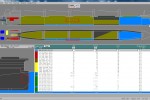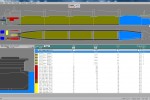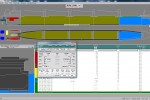Functions and Features
- Interactive graphical profile and plan views of the vessel and compartments
- Display of the actual loading condition and calculated results on the vessel plans
- Selection of Operation mode and automatic selection of the applicable stability criteria:
- Crane Operation Check at any user-defined crane position and load. User interactive ballast adjustment. The user can save any calculated operating position
- Anchor Handling and Towing Operation
- Firefighting Operation
- Pipe Laying Operation
- Heavy Lift Operation
- Cargo densities, definition and conversion
- Cargo Loading by Level of Cargo, Weight, Volume or Percentage
- Tanks Loading by Sound, Ullage, Weight, Volume or Percentage
- Stores and Consumables
- Full validation of user inputs
- Compartments maximum capacity check
- Heeling Moments
- Free Surface Moments
- Constants modification. Dual set of constants (actual and constants as in the loading manual)
- Tank top strength
- Loading Summary, block unloading of a selected load
- Stability Analysis
- 2D or 3D hull model, depending on the loading manual method
- GZ-Theta graphical stability curve
- IMO Criteria, automatic selection as per operation type
- Damage Stability, check actual GM/KG against predefined limiting curves
- Error messages, warning and safety critical (Stability, Strength, Free-board)
- Longitudinal Strength, graphical and interactive read-out at any frame
- Harbour and Sea going limits
- Multiple strength limits as assigned by Class or alternative limits for hogging and sagging
- Ship weight distribution report, to check dry-docking position of supports
- Drafts at the perpendiculars and at the draft marks
- Draft zones selection and adjustment
- Sea-water density effect on the loading condition of the vessel
- Trim Check
- Propeller Immersion
- Storage and retrieval of unlimited number of loading conditions
- Metric, British or mixed system of units and automatic units conversion
- Print outs or complete reports. Text and graphical output
- Import/export of loading conditions. Export conditions by e-mail
- On-line help
General Cargo 2D
- General Cargo loading either in holds or on deck
- “Free Weights”, that is, weights either on-board or outside the vessel
- Crane Operation: Strength/stability calculation, 3D hull model (trim, heel and free-trim effect taken into account)
Auto Trim
Modification of the contents of one compartment or transfer of load between compartments, to achieve the required trim.
SF Correction
Correction of the calculated shearing forces due to loading on alternative holds, according to the pertaining Class rules.
Vessel Particulars
Displays useful information of the vessel, such as tank/hold, deck, machinery details, consumption and so on.
- SAFESALV - Emergency Response
- Damage Stability Check
SAFESALV - Emergency Response
SAFESALV is an advanced system for the immediate assessment of Damage/Grounding vessel conditions and the evaluation of alternative salvage scenarios. SAFESALV provides all those facilities which allow the on-line interactive examination of What If scenarios, making it a powerful decision support tool.
The SAFESALV system is used for Emergency Response.
In SAFESALV the user defines the initial loading condition and indicates the damage on the vessel, working on the actual vessel plan. In case of grounding or combined damage and grounding, the measured draughts at selected points around the vessel, as well as the type, and optionally the extent, of grounding, are input.
As soon as the damage is specified, the floating position in the damaged condition is found. The IMO damage stability criteria are checked and the stresses exerted on the ship’s structure are calculated. User inputs and calculated results are graphically displayed.
Flooding
The cargo permeability can be set by the user. For partially filled holds with bulk cargo, calculation of the combined permeability is carried out. In particular, the system considers the loaded and free space of each hold with different permeabilities. Depending on the calculated in-flooded water level, the combined permeability is found and accounted for.
The damage calculation is based on either liquid surfaces parallel to the waterline or, optionally, on frozen surfaces. Damage conditions can be stored and complete reporting is available.
Marginal points are displayed graphically. In the print out the calculated actual Free-board and Immersion angle at each marginal point are shown.
Cargo Shift
Given the heel of the vessel, the shifted cargo TCG is adjusted so that the calculated heel matches the observed.
Grounding Calculations
Grounding and re-floating calculations include:
- Grounding area
- Grounding force and position
- Force required to free the vessel
- Pressure on grounded area
Different types of grounding, that is, on One Pin, Two Pins or Seabed can be examined. Tide can also be defined and taken into account.
Off-line interactive evaluation of corrective actions/scenarios can be carried out.
Simultaneous flooding and grounding is supported by SAFESALV.
Residual Strength
Provides an estimation of the effect of the structural damages on vessel's strength. The position and extent (in terms of length, breadth and depth) of the structural damages are given by the user. The residual strength is estimated by re-definition of the permissible bending and shear stresses after the structural damages.
Note: SAFESALV is also available as a Stand-Alone Tool.



Damage Stability Check
This module is used to carry Statutory Damage Stability Check. The actual loading is examined for a default number of damage cases built into the system (as specified for the vessel). A complete summary report is produced at the end of calculation for all damage cases, for which the actual loading has been examined. In those cases, where the range of damage conditions to check is not restricted by Class requirement, the option exists for the user to define and check additional user selected damage cases.